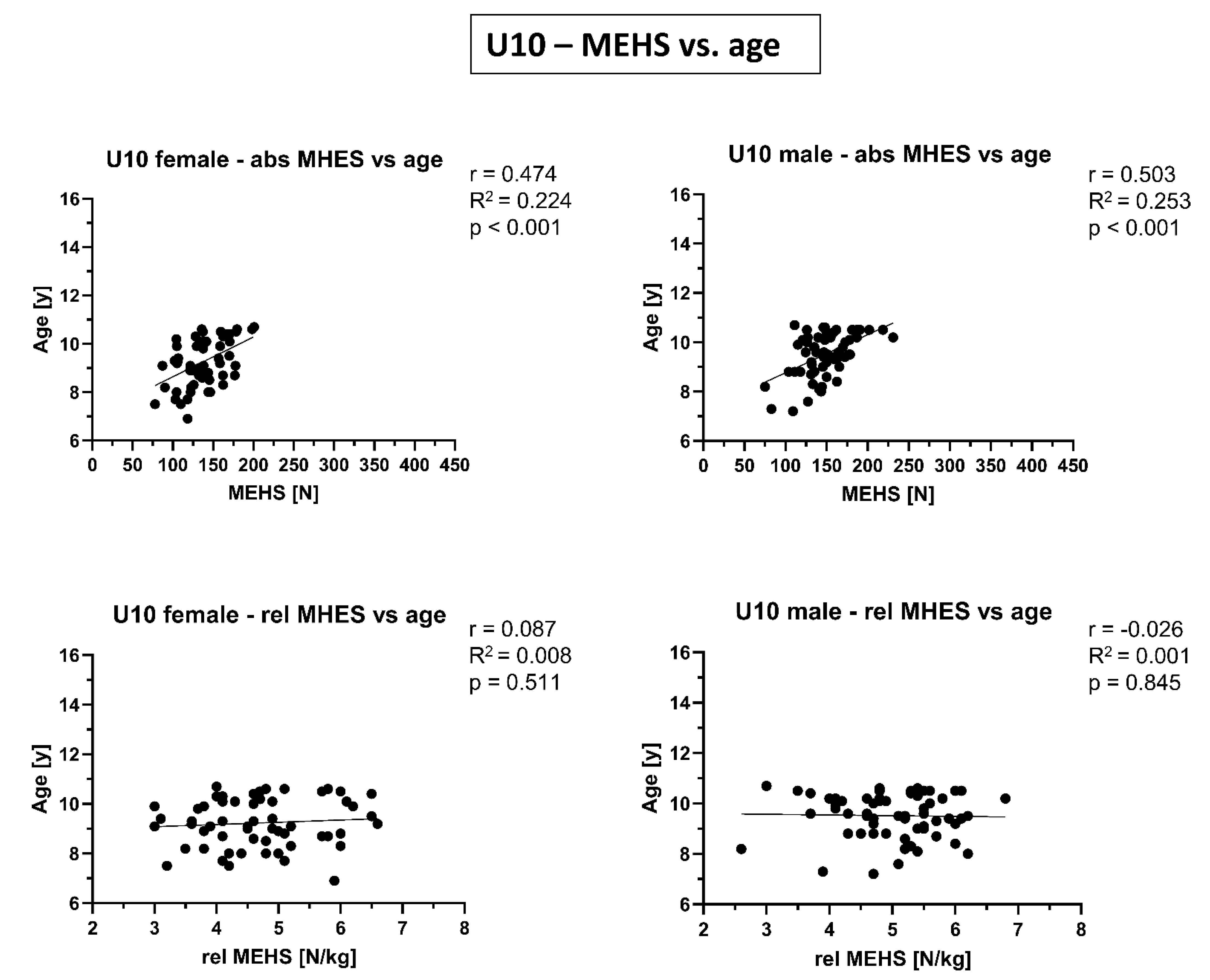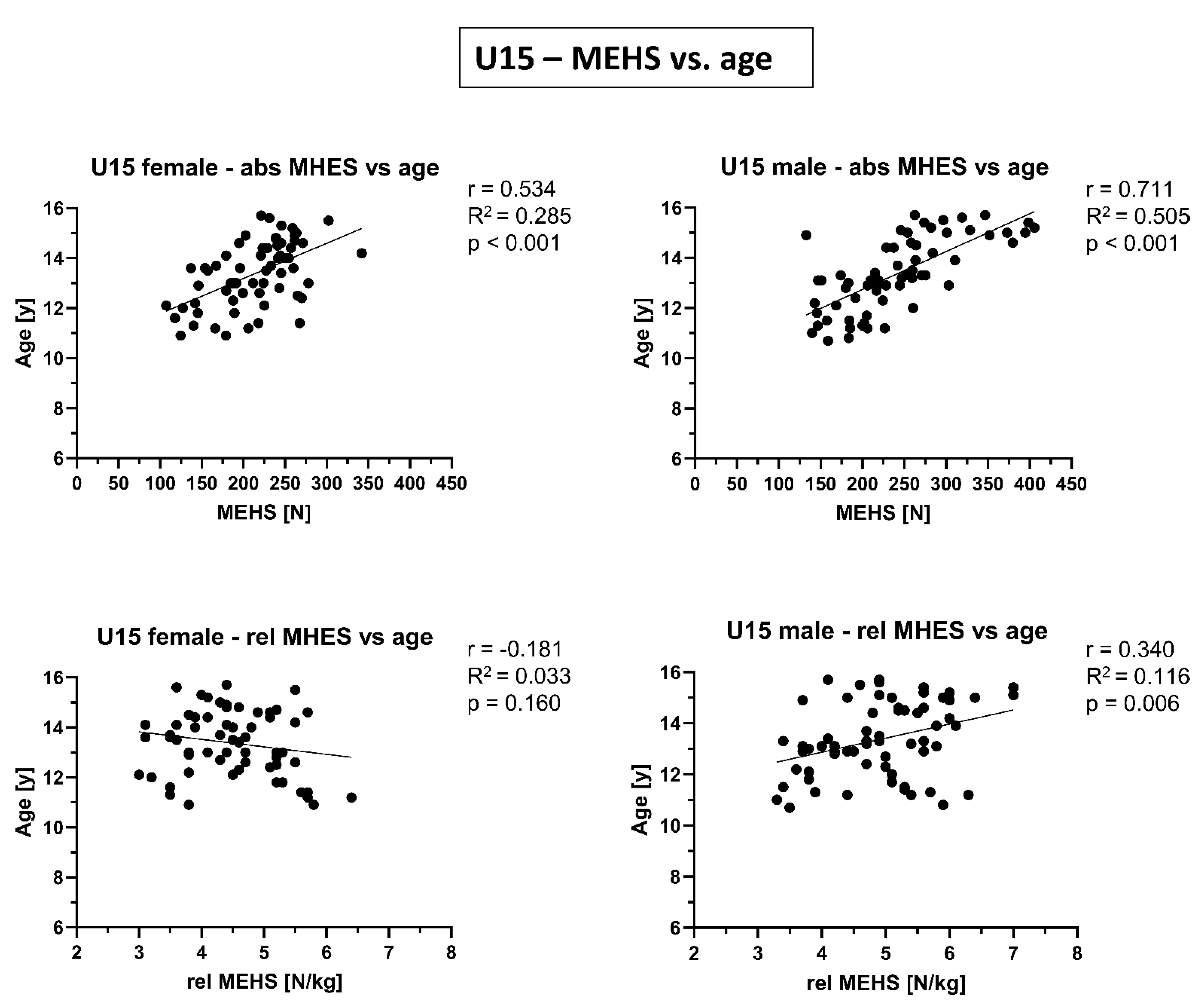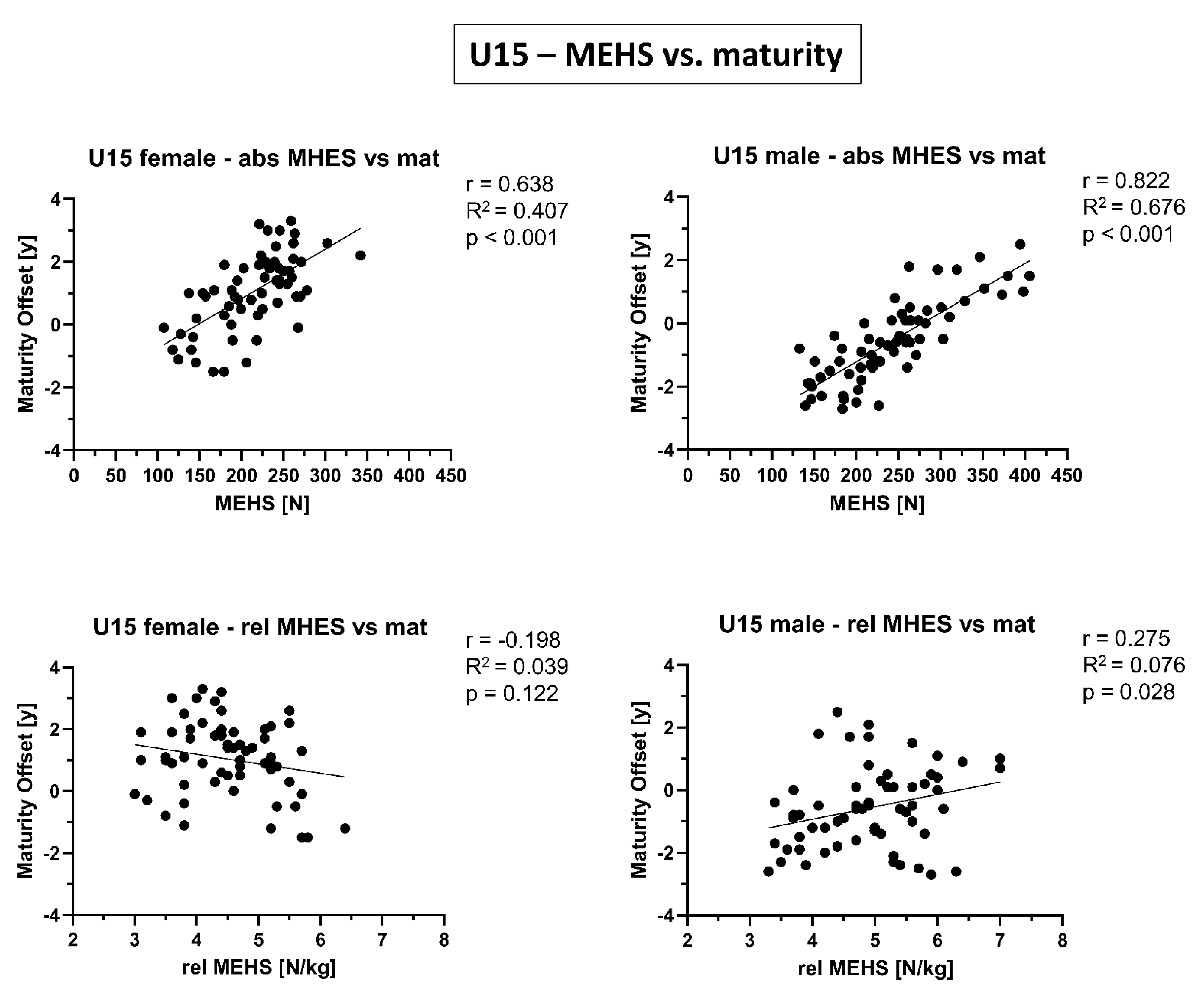A Cross-Sectional Observation on Maximal Eccentric Hamstring Strength in 7- to 15-Year-Old Competitive Alpine Skiers
Abstract
:Simple Summary
Abstract
1. Introduction
2. Materials and Methods
2.1. Study Design, Setting and Participants
2.2. Data Collection and Evaluation
2.2.1. Baseline Data and Determination of Biological Maturity
2.2.2. Maximal Eccentric Hamstrings Strength (MEHS)
2.3. Statistical Analysis
3. Results
3.1. Baseline Data and Biological Maturation
3.2. Differences in Absolute MEHS with Respect to Age and Sex
3.3. Association between MEHS, Sex, Age and Maturity Offset
4. Discussion
4.1. Absolute MEHS in U10 vs. U15 Youth Skiers
4.2. Absolute MEHS in Female vs. Male Youth Skiers
4.3. Relationship between Age, Biological Maturation and MEHS
4.4. Methodological Considerations
5. Conclusions
Author Contributions
Funding
Institutional Review Board Statement
Informed Consent Statement
Data Availability Statement
Conflicts of Interest
References
- Müller, L.; Hildebrandt, C.; Müller, E.; Oberhoffer, R.; Raschner, C. Injuries and illnesses in a cohort of elite youth alpine ski racers and the influence of biological maturity and relative age: A two-season prospective study. Open Access J. Sports Med. 2017, 8, 113–122. [Google Scholar] [CrossRef] [Green Version]
- Schoeb, T.; Peterhans, L.; Fröhlich, S.; Frey, W.O.; Gerber, C.; Spörri, J. Health problems in youth competitive alpine skiing: A 12-month observation of 155 athletes around the growth spurt. Scand. J. Med. Sci Sports 2020, 30, 1758–1768. [Google Scholar] [CrossRef]
- Westin, M.; Alricsson, M.; Werner, S. Injury profile of competitive alpine skiers: A five-year cohort study. Knee Surg. Sport Traumatol. A 2012, 20, 1175–1181. [Google Scholar] [CrossRef]
- Huang, Y.L.; Jung, J.; Mulligan, C.M.S.; Oh, J.; Norcross, M.F. A Majority of Anterior Cruciate Ligament Injuries Can Be Prevented by Injury Prevention Programs: A Systematic Review of Randomized Controlled Trials and Cluster-Randomized Controlled Trials With Meta-analysis. Am. J. Sport Med. 2020, 48, 1505–1515. [Google Scholar] [CrossRef] [PubMed]
- Bizzini, M.; Dvorak, J. FIFA 11+: An effective programme to prevent football injuries in various player groups worldwide—A narrative review. Br. J. Sports Med. 2015, 49, 577–579. [Google Scholar] [CrossRef]
- Soomro, N.; Sanders, R.; Hackett, D.; Hubka, T.; Ebrahimi, S.; Freeston, J.; Cobley, S. The Efficacy of Injury Prevention Programs in Adolescent Team Sports: A Meta-analysis. Am. J. Sport Med. 2016, 44, 2415–2424. [Google Scholar] [CrossRef] [PubMed]
- Silvers-Granelli, H.J.; Bizzini, M.; Arundale, A.; Mandelbaum, B.R.; Snyder-Mackler, L. Does the FIFA 11+ Injury Prevention Program Reduce the Incidence of ACL Injury in Male Soccer Players? Clin. Orthop. Relat. Res. 2017, 475, 2447–2455. [Google Scholar] [CrossRef] [PubMed]
- Steffen, K.; Emery, C.A.; Romiti, M.; Kang, J.; Bizzini, M.; Dvorak, J.; Finch, C.F.; Meeuwisse, W.H. High adherence to a neuromuscular injury prevention programme (FIFA 11+) improves functional balance and reduces injury risk in Canadian youth female football players: A cluster randomised trial. Br. J. Sports Med. 2013, 47, 794–802. [Google Scholar] [CrossRef] [Green Version]
- Spörri, J.; Kröll, J.; Gilgien, M.; Müller, E. How to Prevent Injuries in Alpine Ski Racing: What Do We Know and Where Do We Go from Here? Sports Med. 2017, 47, 599–614. [Google Scholar] [CrossRef] [PubMed] [Green Version]
- Bere, T.; Florenes, T.W.; Krosshaug, T.; Koga, H.; Nordsletten, L.; Irving, C.; Muller, E.; Reid, R.C.; Senner, V.; Bahr, R. Mechanisms of anterior cruciate ligament injury in World Cup alpine skiing: A systematic video analysis of 20 cases. Am. J. Sports Med. 2011, 39, 1421–1429. [Google Scholar] [CrossRef]
- Bere, T.; Mok, K.M.; Koga, H.; Krosshaug, T.; Nordsletten, L.; Bahr, R. Kinematics of anterior cruciate ligament ruptures in World Cup alpine skiing: 2 case reports of the slip-catch mechanism. Am. J. Sport Med. 2013, 41, 1067–1073. [Google Scholar] [CrossRef]
- Jordan, M.J.; Aagaard, P.; Herzog, W. Anterior cruciate ligament injury/reinjury in alpine ski racing: A narrative review. Open Access J. Sports Med. 2017, 8, 71–83. [Google Scholar] [CrossRef] [Green Version]
- Bere, T.; Florenes, T.W.; Krosshaug, T.; Haugen, P.; Svandal, I.; Nordsletten, L.; Bahr, R. A systematic video analysis of 69 injury cases in World Cup alpine skiing. Scand. J. Med. Sci. Spor 2014, 24, 667–677. [Google Scholar] [CrossRef]
- Li, G.; Rudy, T.W.; Sakane, M.; Kanamori, A.; Ma, C.B.; Woo, S.L. The importance of quadriceps and hamstring muscle loading on knee kinematics and in-situ forces in the ACL. J. Biomech. 1999, 32, 395–400. [Google Scholar] [CrossRef]
- Natri, A.; Beynnon, B.D.; Ettlinger, C.F.; Johnson, R.J.; Shealy, J.E. Alpine ski bindings and injuries. Current findings. Sports Med. 1999, 28, 35–48. [Google Scholar] [CrossRef] [PubMed]
- Pujol, N.; Blanchi, M.P.; Chambat, P. The incidence of anterior cruciate ligament injuries among competitive Alpine skiers: A 25-year investigation. Am. J. Sport Med. 2007, 35, 1070–1074. [Google Scholar] [CrossRef] [PubMed]
- Petushek, E.J.; Sugimoto, D.; Stoolmiller, M.; Smith, G.; Myer, G.D. Evidence-Based Best-Practice Guidelines for Preventing Anterior Cruciate Ligament Injuries in Young Female Athletes: A Systematic Review and Meta-analysis. Am. J. Sport Med. 2019, 47, 1744–1753. [Google Scholar] [CrossRef]
- Luchner, R.; Steidl-Muller, L.; Niedermeier, M.; Raschner, C. Maximal Isometric or Eccentric Hamstring Strength-Which Test Modality Might Be More Suitable for Assessments in Youth Alpine Ski Racers? Int. J. Environ. Res. Public Health 2021, 18, 2138. [Google Scholar] [CrossRef] [PubMed]
- Franchi, M.V.; Ellenberger, L.; Javet, M.; Bruhin, B.; Romann, M.; Frey, W.O.; Spörri, J. Maximal Eccentric Hamstrings Strength in Competitive Alpine Skiers: Cross-Sectional Observations From Youth to Elite Level. Front. Physiol. 2019, 10, 88. [Google Scholar] [CrossRef]
- Mirwald, R.L.; Baxter-Jones, A.D.; Bailey, D.A.; Beunen, G.P. An assessment of maturity from anthropometric measurements. Med. Sci. Sports Exerc 2002, 34, 689–694. [Google Scholar]
- Sherar, L.B.; Baxter-Jones, A.D.; Faulkner, R.A.; Russell, K.W. Do physical maturity and birth date predict talent in male youth ice hockey players? J. Sports Sci. 2007, 25, 879–886. [Google Scholar] [CrossRef]
- Müller, L.; Müller, E.; Hildebrandt, C.; Kapelari, K.; Raschner, C. The assessment of biological maturation for talent selection—Which method can be used? Sportverletz Sportschaden 2015, 29, 56–63. [Google Scholar] [CrossRef]
- Malina, R.M.; Dompier, T.P.; Powell, J.W.; Barron, M.J.; Moore, M.T. Validation of a noninvasive maturity estimate relative to skeletal age in youth football players. Clin. J. Sport Med. 2007, 17, 362–368. [Google Scholar] [CrossRef] [PubMed]
- Malina, R.M.; Koziel, S.M. Validation of maturity offset in a longitudinal sample of Polish boys. J. Sports Sci. 2014, 32, 424–437. [Google Scholar] [CrossRef]
- Malina, R.M.; Koziel, S.M. Validation of maturity offset in a longitudinal sample of Polish girls. J. Sports Sci. 2014, 32, 1374–1382. [Google Scholar] [CrossRef]
- Bourne, M.N.; Opar, D.A.; Williams, M.D.; Shield, A.J. Eccentric Knee Flexor Strength and Risk of Hamstring Injuries in Rugby Union: A Prospective Study. Am. J. Sport Med. 2015, 43, 2663–2670. [Google Scholar] [CrossRef]
- Opar, D.A.; Piatkowski, T.; Williams, M.D.; Shield, A.J. A novel device using the Nordic hamstring exercise to assess eccentric knee flexor strength: A reliability and retrospective injury study. J. Orthop. Sports Phys. Ther. 2013, 43, 636–640. [Google Scholar] [CrossRef] [Green Version]
- Timmins, R.G.; Bourne, M.N.; Shield, A.J.; Williams, M.D.; Lorenzen, C.; Opar, D.A. Short biceps femoris fascicles and eccentric knee flexor weakness increase the risk of hamstring injury in elite football (soccer): A prospective cohort study. Br. J. Sports Med. 2016, 50, 1524–1535. [Google Scholar] [CrossRef] [PubMed]
- West, S.G.; Finch, J.F.; Curran, P.J. Structural Equation Models with Nonnormal Variables: Problems and Remedies; Sage Publications, Inc.: Thousand Oaks, CA, USA, 1995. [Google Scholar]
- Opar, D.A.; Williams, M.D.; Timmins, R.G.; Hickey, J.; Duhig, S.J.; Shield, A.J. Eccentric hamstring strength and hamstring injury risk in Australian footballers. Med. Sci. Sports Exerc. 2015, 47, 857–865. [Google Scholar] [CrossRef] [Green Version]
- Philippaerts, R.M.; Vaeyens, R.; Janssens, M.; Van Renterghem, B.; Matthys, D.; Craen, R.; Bourgois, J.; Vrijens, J.; Beunen, G.; Malina, R.M. The relationship between peak height velocity and physical performance in youth soccer players. J. Sports Sci. 2006, 24, 221–230. [Google Scholar] [CrossRef] [PubMed]
- Hewett, T.E.; Myer, G.D.; Ford, K.R.; Heidt, R.S., Jr.; Colosimo, A.J.; McLean, S.G.; van den Bogert, A.J.; Paterno, M.V.; Succop, P. Biomechanical measures of neuromuscular control and valgus loading of the knee predict anterior cruciate ligament injury risk in female athletes: A prospective study. Am. J. Sport Med. 2005, 33, 492–501. [Google Scholar] [CrossRef] [Green Version]
- Hewett, T.E.; Myer, G.D.; Ford, K.R.; Slauterbeck, J.R. Preparticipation physical examination using a box drop vertical jump test in young athletes: The effects of puberty and sex. Clin. J. Sport Med. 2006, 16, 298–304. [Google Scholar] [CrossRef]
- Jordan, M.J.; Aagaard, P.; Herzog, W. Rapid hamstrings/quadriceps strength in ACL-reconstructed elite Alpine ski racers. Med. Sci. Sports Exerc. 2015, 47, 109–119. [Google Scholar] [CrossRef] [PubMed] [Green Version]
- Färber, S.; Heinrich, D.; Werner, I.; Federolf, P. Is it possible to voluntarily increase hamstring muscle activation during landing from a snow jump in alpine skiing?—A pilot study. J. Sport Sci. 2018, 37, 1–8. [Google Scholar] [CrossRef] [PubMed]
- Ellenberger, L.; Casutt, S.; Fröhlich, S.; Frey, W.O.; Snedeker, J.G.; Spörri, J. Thigh muscle activation patterns and dynamic knee valgus at peak ground reaction force during drop jump landings: Reliability, youth competitive alpine skiing-specific reference values and relation to knee overuse complaints. J. Sci. Med. Sport 2021. [Google Scholar] [CrossRef] [PubMed]
- Flaxman, T.E.; Alkjaer, T.; Simonsen, E.B.; Krogsgaard, M.R.; Benoit, D.L. Predicting the Functional Roles of Knee Joint Muscles from Internal Joint Moments. Med. Sci. Sports Exerc. 2017, 49, 527–537. [Google Scholar] [CrossRef] [PubMed]




| Variables | U10 Skiers | U15 Skiers | ||||
|---|---|---|---|---|---|---|
| Overall (n = 120) | Female (n = 59) | Male (n = 61) | Overall (n = 126) | Female (n = 62) | Male (n = 64) | |
| Age (y) | 9.4 ± 0.9 (6.9–10.7) | 9.2 ± 1.0 (6.9–10.7) | 9.5 ± 0.9(7.2–10.7) | 13.4 ± 1.4 (10.8–15.7) | 13.4 ± 1.3 (10.9–15.7) | 13.4 ± 1.5 (10.8–15.7) |
| Body height (cm) | 135.1 ± 7.4 (118.0–157.0) | 133.9 ± 7.0 (118.0–157.0) | 136.3 ± 7.7 (118.0–152.0) | 158.3 ± 10.3 (136.0–187.0) | 156.7 ± 8.8 (136.0–177.0) | 159.8 ± 11.4 (140.0–187.0) |
| Body weight (kg) | 29.7 ± 4.9 (20.0–50.0) | 29.4 ± 5.3 (20.0–50.0) | 30.1 ± 4.6 (21.0–41.0) | 48.5 ± 10.0 (28.0–90.0) | 47.9 ± 9.5 (28.0–65.0) | 49.1 ± 10.5 (31.0–90.0) |
| BMI (kg/m2) | 16.2 ± 1.7 (13.2–21.8) | 16.3 ± 1.9 (13.2–21.4) | 16.1 ± 1.4 (13.6–21.8) | 19.2 ± 2.2 (15.1–28.4) | 19.3 ± 2.2 (15.1–24.7) | 19.1 ± 2.3 (15.2–28.4) |
| Maturity offset (y) | - | - | - | 0.2 ± 1.5 (−2.7–3.3) | 1.0 ± 1.2 (−1.5–3.3) | −0.6 ± 1.3 (−2.7–2.5) |
| APHV (y) | - | - | - | 13.2 ± 1.0 (11.5–15.7) | 12.3 ± 0.4 (11.5–13.3) | 13.9 ± 0.6 (12.5–15.7) |
Publisher’s Note: MDPI stays neutral with regard to jurisdictional claims in published maps and institutional affiliations. |
© 2021 by the authors. Licensee MDPI, Basel, Switzerland. This article is an open access article distributed under the terms and conditions of the Creative Commons Attribution (CC BY) license (https://creativecommons.org/licenses/by/4.0/).
Share and Cite
Kiers, K.; Ellenberger, L.; Javet, M.; Bruhin, B.; Frey, W.O.; Spörri, J. A Cross-Sectional Observation on Maximal Eccentric Hamstring Strength in 7- to 15-Year-Old Competitive Alpine Skiers. Biology 2021, 10, 1128. https://doi.org/10.3390/biology10111128
Kiers K, Ellenberger L, Javet M, Bruhin B, Frey WO, Spörri J. A Cross-Sectional Observation on Maximal Eccentric Hamstring Strength in 7- to 15-Year-Old Competitive Alpine Skiers. Biology. 2021; 10(11):1128. https://doi.org/10.3390/biology10111128
Chicago/Turabian StyleKiers, Kirsten, Lynn Ellenberger, Marie Javet, Björn Bruhin, Walter O. Frey, and Jörg Spörri. 2021. "A Cross-Sectional Observation on Maximal Eccentric Hamstring Strength in 7- to 15-Year-Old Competitive Alpine Skiers" Biology 10, no. 11: 1128. https://doi.org/10.3390/biology10111128
APA StyleKiers, K., Ellenberger, L., Javet, M., Bruhin, B., Frey, W. O., & Spörri, J. (2021). A Cross-Sectional Observation on Maximal Eccentric Hamstring Strength in 7- to 15-Year-Old Competitive Alpine Skiers. Biology, 10(11), 1128. https://doi.org/10.3390/biology10111128







